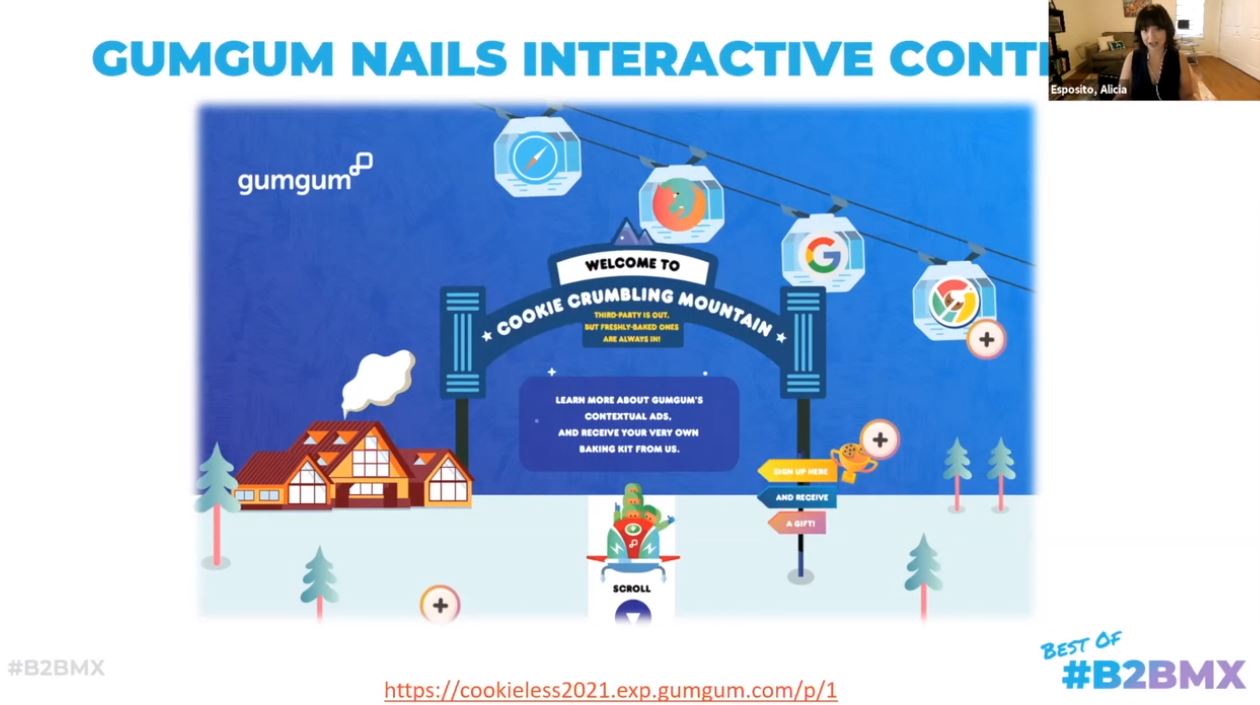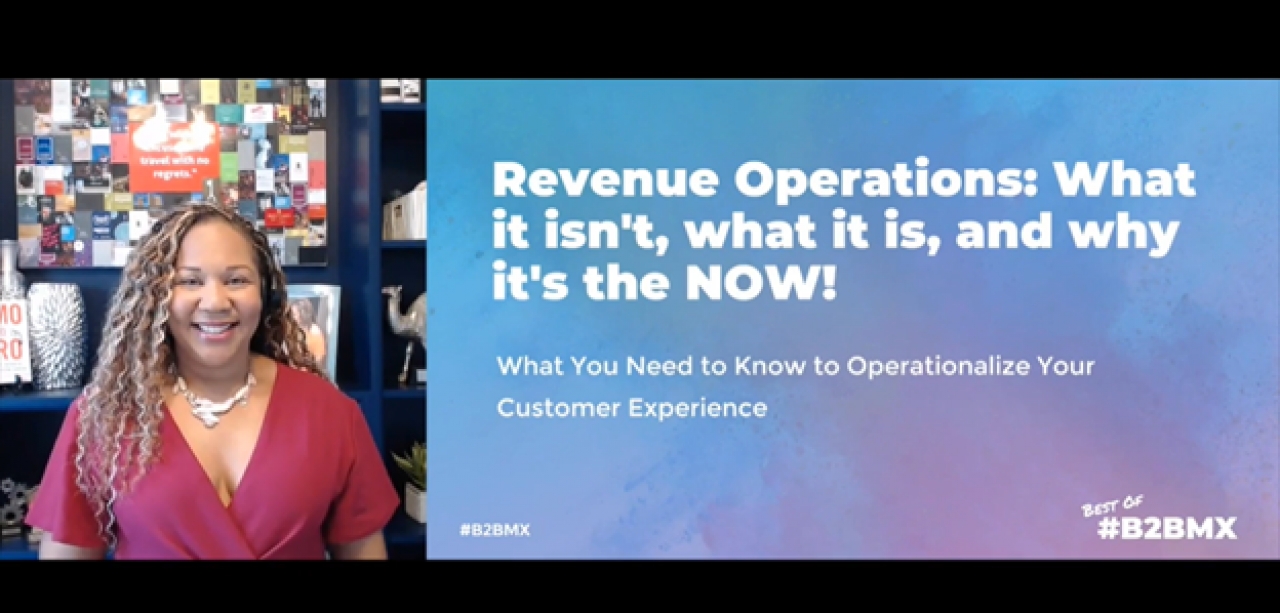Best Of #B2BMX: Beloved Classics & New Releases Dominate The B2B Airwaves As RevOps, Interactive Brand Storytelling & Personalized Content Take Center Stage
- Written by Kelly Lindenau & Michael Rodriguez
- Published in Industry Insights
It’s in the name: The Best of B2BMX (#BOB2BMX) event series highlighted the best sessions from Demand Gen Report’s (DGR) B2BMX 2021 event series. Not wanting to relegate its presenters to one hit wonder status, the DGR team combed through our blockbuster presentations to curate a targeted selection of high-rated content that covers everything from revenue operations (RevOps) to content customization.
In an event dominated by a collection of fan favorite sessions, contenders for best new artist entered the fold. Perhaps the most exciting was Brandi Starr, Chief Operations Officer of Tegrita, and her keynote, “Revenue Operations: What It Isn't, What It Is & Why It's The NOW!” With a focus on clearing up common misconceptions about RevOps, she strengthened her key points through a series of metaphors, analogies and plenty of statistics.
As Starr walked attendees through the importance of breaking siloes, bringing customer experience (CX) into RevOps with technology and the power of personalization, she explained that RevOps isn’t an independent project or disparate “side hustle” — it’s a full-time responsibility for organizations. For true success and operational efficiency, the RevOps team must be centralized and not operating independently.
“RevOps is meant to bring businesses together so they can operate as one unit with a common goal of driving revenue and creating a secure customer experience,” Starr said in the keynote. “Every function is going to share common objectives, KPIs, measurements and data to improve the efficiency and effectiveness of your go-to-market (GTM) strategy. Each team still plays their unique role — sales will still focus functionally on sales; marketing will still focus functionally on marketing — but they will operate as one cohesive unit. If you don’t have someone who is looking across all operations of the business, you’ll actually exacerbate the silo problem.”
Starr continued that RevOps is a strategic alignment of all departments that contribute to revenue goals. RevOps programs that are properly constructed help identify the best tools needed to meet departmental goals across operational managers, tech stack managers, data and insight provisions and organization-wide enablement.
“Changing the way your operations are aligned and operate gives your organization a chance to perform in its optimal state — this benefits you and your customers,” said Starr. “Making a change gives you a chance. Revenue operations isn’t the future; it is the NOW.”
Starr’s insights were backed up in Christine Nurnberger’s “Revenue Operations: The Next Frontier In B2B Marketing,” where she dove further into the alignment structures. This includes:
- Interlocking processes, such as ideal customer profiles (ICP) and go-to-market (GTM) prioritization;
- Measurements and systems, including funnel to pipeline stage to closed/won;
- Waterfall performance and lifetime customer value;
- SLAs;
- End-to-end view of buyer behavior; and
- A repeatable revenue model.
“There’s so much more than just marketing, sales and product alignment that goes into RevOps,” said Nurnberger. “It’s the supporting processes, the underlying data and insights and analytics that are allowing you as an organization to make better decisions throughout marketing processes. It’s also facilitating and enabling sales, helping the organization truly understand the dynamics that are happening within the sales cycle and making the company a great place to buy and sell.”
Personalizing Content Offerings For Increased Engagement
To analyze buyer data to inform content creation, day two featured a case study from the Pragmatic Institute, aptly titled: “How Pragmatic Institute Got 3X More Website Engagement Using Content Intelligence.” Rebecca Kalogeris, VP of Marketing and Product Strategy for the company, explained how it utilized PathFactory’s AI platform to analyze its website’s inbound and outbound traffic to determine its visitors’ areas of interest. This enabled the company to curate new clusters of content that matched the visitor’s previous activity each time they entered their website, creating a “Netflix of thought leadership content” buyers can engage with at their leisure.
“This is why content analysis is so powerful,” explained Kalogeris. “The AI reads through all your content, analyzes visitor’s activity and uses that to determine which content will be the most relevant. This allows us to leverage new and legacy content for buyer engagement through automatic content recommendations and related content tabs.”
Content optimization was also viewed through the lens of interactivity with BMC Software’scase study, “How BMC Proved The Value Of Interactive Content & Ramped Up ROI.” Throughout the session, the organization discussed how it worked with Content4Demand to create a SaaS-inspired multi-link infographic to complement its blog posts. The infographic provided buyers with full control over their content experience, allowing them to click on and learn more about specific topics within a blog post for additional content engagement.
“It’s a double entendre that suggests to the user that they can interact with content,” said Stephen Watts, Director of Web Marketing at BMC. “It tells our buyers that not only are they in control over their cloud computing needs, they’re in control of the content in the moment on the blog post.”
Interactive Branded Experiences Increase Awareness & Buyer Motivation

DGR’s Klaudia Tirico and Retail TouchPoints’ Alicia Esposito highlighted the impact of interactive content on branded experiences, encouraging organizations to “have fun” with their content, as “B2B no longer needs to be boring,” Tirico explained.
Esposito emphasized Tirico’s point by referencing the 2021 Killer Content Awards, explaining how most of the winners’ strategies featured fun, interactive content.
She specifically discussed GumGum and its “Cookie Crumbling Mountain” content, an experience that allowed buyers to explore the breakdown of cookie data. Buyers engaged with topical information and learned about GumGum’s data offering, which increased brand awareness while building buyer trust.
“Within interactive content, there are so many opportunities to create different paths,” Esposito explained. “Including these elements of personalization and customization in your interactive content gives your audience the power to go as high level or deep into the experience as they want. You can then track those metrics to determine who is engaged and focus on the ones resonating with your brand.”
In a separate session, Marketing Interaction's Ardath Albee highlighted how interactive brand experiences increase buyer motivation to take action with a brand. Something as simple as product demos can help buyers assess a brand’s value, increasing engagement through a buyer’s direct interaction with the people behind the brand.
“When I say interactive experiences, I’m not just talking about quizzes and surveys,” Albee explained. “I’m talking about value assessments where they work directly with you to determine what their ROI will be. Virtual product tours and demos allow buyers to delve into specific areas of products to help them understand the different features that will be important to them and bringing about deeper engagement with the brand.”
That’s not all the insights we have, though. Make sure to join the DGR team at the B2B Marketing Exchange in Scottsdale, Ariz. from Feb. 28 to March 22, 2022. Register for the event now and stay up to date with the latest news and updates.


